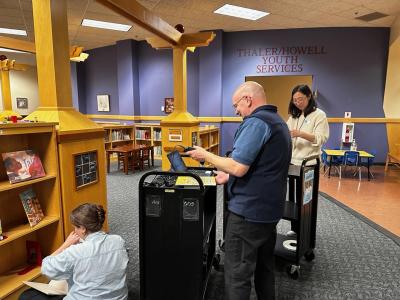
The RFID Project
If you have been in the library lately, you may have heard our staff mention something about our upcoming RFID project. Well, the project is underway! Our staff has been busy putting RFID tags into books, so that our new RFID readers will be able to read them and get you and your stacks of materials checked out (and in) even faster! But, what is RFID? Why are we doing this? How does it work? What does it mean for you, the patron?
What is RFID technology?
Radio Frequency Identification (RFID) technology uses radio waves to identify objects. An object is tagged with an RFID sticker, which is a device that transmits very low-frequency radio waves. These tags are then read by RFID receivers, which can come in the form of receiver pads at staff desks and self-check-out machines!
How does RFID benefit TCPL (and me)?
RFID technology helps improve the speed and accuracy of circulation and shelving, thereby freeing library staff to provide more direct services to patrons (YOU!). It also helps protect the library’s collection and ensures that the community gets the most value out of the library. The cost of installing an RFID system is usually recouped within two years – and the benefits of the system can last for decades or more.
Why is TCPL implementing RFID now?
The current technology we are using is outdated. Most of it can’t be replaced and vendors no longer support it. Several years ago, the Library began extensive research and determined that RFID would help us become more accurate, efficient, and customer service-focused. After careful planning and budgeting, TCPL is now at the implementation phase.
How do I use RFID?
After tagging all TCPL materials, RFID will work in a variety of ways to serve patrons and staff:
- New (sleek, modern) self-check machines for easier checkout
- New gates to help alert patrons when an item hasn’t been checked out (this also helps with theft deterrence)
- Eventual introduction of a phone app that will allow for mobile checkout in the stacks
- Faster inventorying by staff to help find missing materials and ensure accurate loan status
Is RFID safe for patrons? Can it interfere with my pacemaker? Will it read my credit card?
RFID technology has been commercially available in one form or another since the 1970s. It is now part of our daily lives and can be found in car keys, employee identification, medical history/billing, highway toll tags, and security access cards. It will not affect your pacemaker (or any health devices) or credit cards. Nor does the library keep any sensitive data such as social security numbers that could be transmitted.
Can I still check out materials from other libraries?
Yes. Material barcodes will remain, allowing checkout across the Finger Lakes Library System’s (FLLS) 33 member libraries.
Will I have to use a self-check machine?
No. Staff will always be available to assist patrons directly.
How are the new self-check machines better than the current ones?
The new machines are standalone and easier to access. We will have more in more convenient and obvious locations. They will allow users to check out a stack of materials instead of placing items one-by-one. They are faster and quieter, and we think you will enjoy using them!
How will I know if my material has RFID? What do the shiny stickers on the book spines mean?
Materials that are tagged and linked in the system are stickered to signify they’ve been processed for RFID.
Are other FLLS libraries implementing RFID?
Not currently. TCPL is lucky to have the budget and capacity to take on a project this large.
Will I need a new library card?
No! Your current library card works with RFID.
